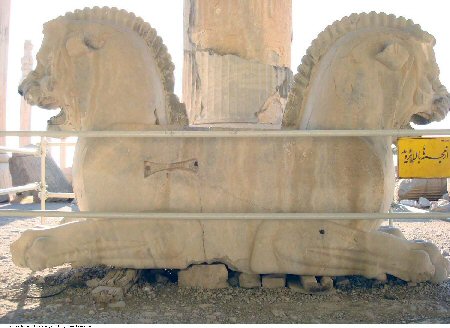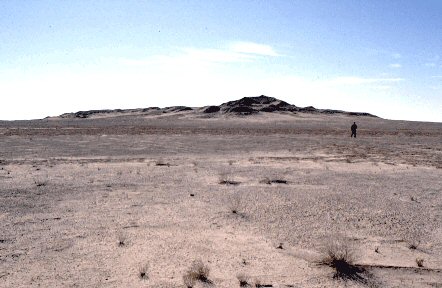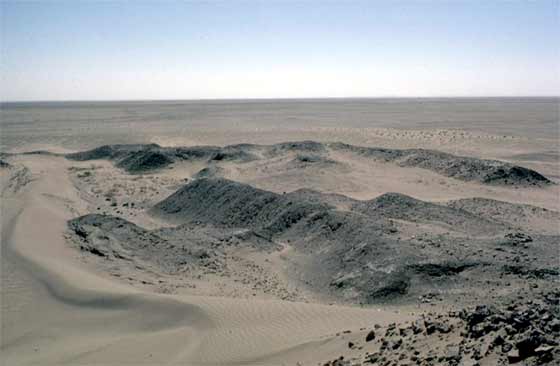|
Location:
Tell
Abu Shahrain, Iraq. |
Grid Reference:
45� 58' 40" E, 30� 47' 51" N. |

 Eridu:
(Sumerian City State).
Eridu:
(Sumerian City State).
Said to be the first and oldest Sumerian city
and capital of the Early Dynastic Period. According to
Sumerian tradition, the city that was founded by and belonged to
the god Enki, the god of wisdom.
Eridu was considered an
Earth Navel.
(Click here for Map of
site)
|
Eridu:
('Mighty
Place', 'Eridug') |
The site of Eridu was
discovered by J. E. Taylor in 1854, in a ruin then called by the natives
AbuShahrein, a few miles south-south-west of Moghair, ancient Ur, nearly
in the centre of the dry bed of an inland sea. Eridu was once a
thriving Sumerian sea-port, and was inhabited for over 2,000 years.
The ruins, in which Taylor conducted brief excavations, consist of a
platform of fine sand
enclosed by a sandstone wall, 20 ft. high, the corners orientated toward the
cardinal points, on the N.W. part of which was a pyramidal tower
of two stages, constructed of sun-dried brick, cased with a wall of kiln-burned
brick, the whole still standing to a height of about 70 ft. above the
platform. The summit of the first stage was reached by a
staircase on the S.E. side, 15 ft. wide and 70 ft. long, constructed
of polished marble
slabs, fastened with copper
bolts, flanked at the foot by two curious columns. An inclined road led
up to the second stage on the N.W. side. Pieces of polished
alabaster and marble, with small pieces of pure gold and
gold-headed copper nails, found on and about the top of the second
stage, indicated that a small but richly adorned sacred chamber,
apparently plated within or without in gold, formerly crowned the top of
this structure. Around the whole tower was a
pavement of inscribed baked bricks, resting on a layer of clay 2
ft. thick. On the S.E. part of the
terrace were the remains of several edifices, containing suites of
rooms. Inscriptions on the bricks identified the site as that of Eridu.
Eridu is best known for its temples, called ziggurats. The earliest
temple, dated to the Ubaid period about 5570 BC, consisted of a small
room with a possible cult niche and an offering table. After a break,
there are ever-larger temples built and rebuilt on this site throughout
its history. Each of these temples was built with classical early
Mesopotamian format of tripartite plan, with a buttressed facade and a
long central room with an altar. The Ziggurat of Enki was built for the
Third Dynasty of Ur, 3,000 years after the city's founding.
|
"[nam]-lugal an-ta �d-d�-a-ba
[eri]duki nam-lugal-la"
"When kingship from heaven was lowered,
the kingship was in Eridu."
(Sumerian king-list).
|
Chronology:
construction phases -
The lowest building
levels at Eridu (XVIII to XV), revealed small houses and shrines built
of mud-brick to rectangular plans. This phase dates back to 5,000
BC. (1)
The next phase (Hajji
Muhammed), began about 4,750 BC and occupies five building levels.
This phase was well represented across southern Mesopotamia. It
develops into the third phase. (1)
The third phase of
development was named after the site Al 'Ubaid'. The Ubaid people
spread across the whole of Mesopotamia. They used gold and copper
and casted axes (1)
The Ubaid were
succeeded by the Uruk phase which lasted from around 3,800 - 3,200 BC.
The first evidence of writing was discovered at this level.
(1)
Eridu Ziggurat: The Tower of Babel?
The tower of Babel was, according to the Bible
(Genesis), built in Babylon.
According to the biblical
account, a united humanity of the generations following the
Great Flood, speaking a single language and migrating from the
east, participated in the building. The people decided their city
should have a tower so immense that it would have "its top in the
heavens". (3)
However, the Tower of Babel was
not built for the worship and praise of God, but was instead dedicated
to the glory of man, to "make a name" for the builders: "Then they
said, 'Come, let us build ourselves a city, and a tower with its top
in the heavens, and let us make a name for ourselves; otherwise we
shall be scattered abroad upon the face of the whole earth.'" (Genesis
11:4). God, seeing what the people were doing, came down and confused
their languages and scattered the people throughout the earth.
It has been suggested that Eridu,
to the south of Ur, was the original Babel and site of the Tower of
Babel, rather than the later city of Babylon, for a variety of reasons.
(9)
-
The ziggurat ruins of Eridu are far larger and older than any
others, and seem to best match the Biblical description of the
unfinished Tower of Babel.
-
One name of Eridu in cuneiform logograms was pronounced "NUN.KI"
("the Mighty Place") in Sumerian, but much later the same "NUN.KI" was
understood to mean the city of Babylon.
-
The much later Greek version of the King-list by Berosus (c. 200
BC) reads "Babylon" in place of "Eridu" in the earlier versions, as
the name of the oldest city where "the kingship was lowered from
Heaven".
-
Rohl et al. further equate Biblical Nimrod, said to have
built Erech (Uruk) and Babel, with the name Enmerkar (-KAR meaning
"hunter") of the king-list and other legends, who is said to have
built temples both in his capital of Uruk and in Eridu.
Other cities in the ancient Near
East were also named as "Babylon" at some point in history, including
Nineveh. (10)
Eridu in Mythology:
In Sumerian mythology, it was said to be one of the five cities built
before the Deluge occurred. Eridu appears to be the earliest settlement
in the region, founded ca. 5400 BC, close to the Persian Gulf near the
mouth of the Euphrates River. Because of accumulation of silt at the
shoreline over the millennia, the remains of Eridu are now some distance
from the gulf at Abu Shahrain in Iraq.
In early Eridu, Enki's temple was known as E-abzu, or E-engura
("House of the subterranean waters" due to Enki's association with
water), and was located at the edge of a freshwater marsh, an abzu.
(2)
Gallery of Images: Eridu Ziggurat.


(More about Sumeria)
|


